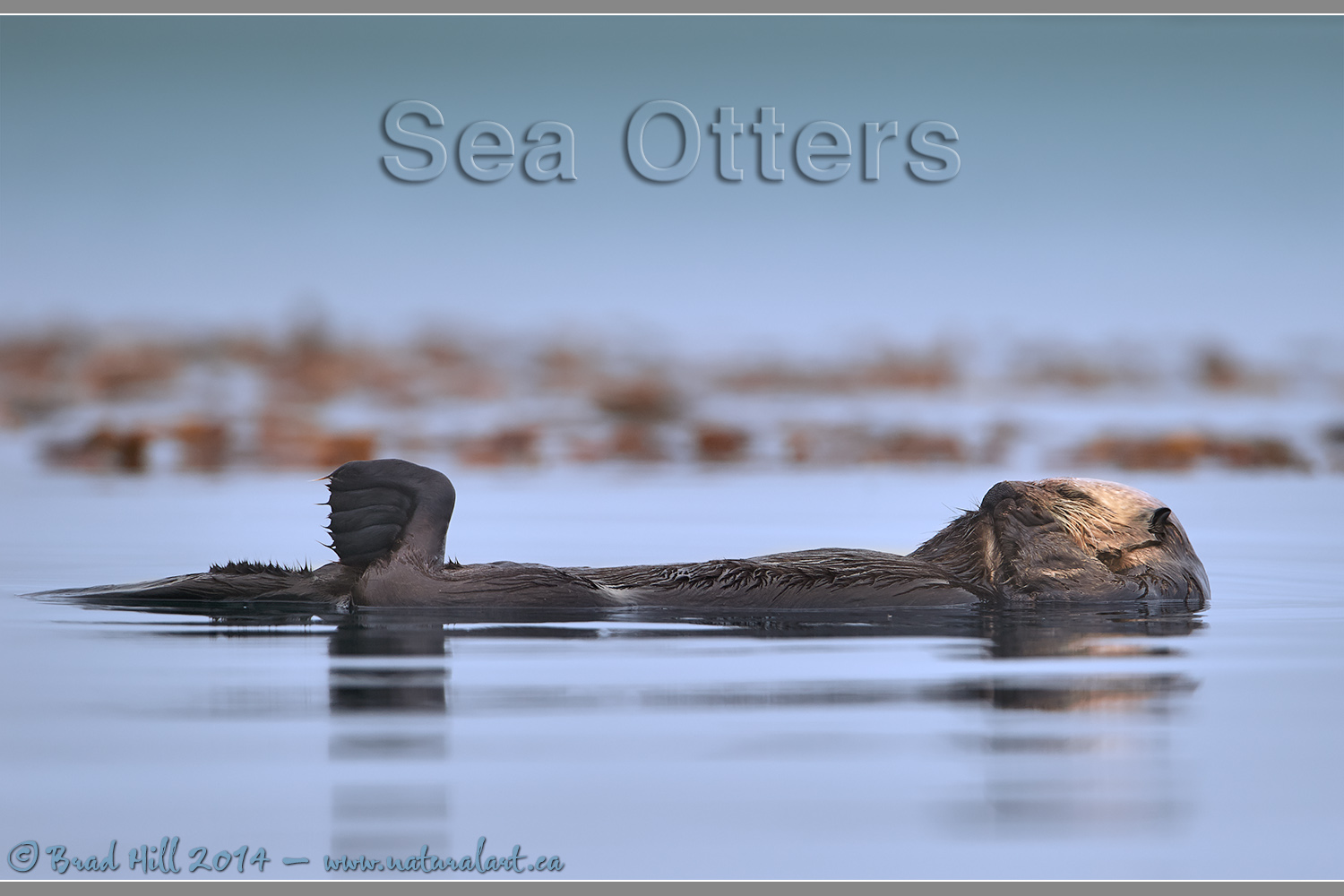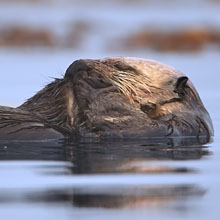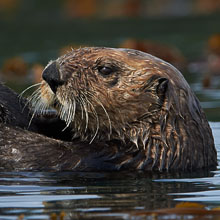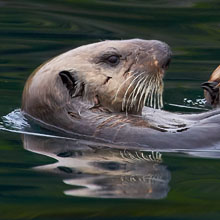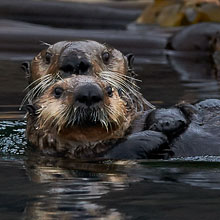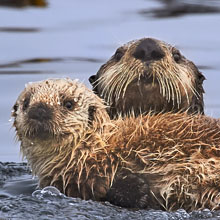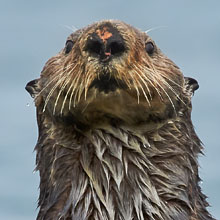Availability: Undetermined - Enquiries?
In the Field
A Floating Forty Winks. Northern Vancouver Island, BC, Canada. August 8, 2014.
Sea Otters are absolutely fascinating animals. And they're also a completely unique marine mammal. They're the only fully marine mammal on earth that doesn't use body fat and/or "blubber" to help insulate itself from the heat-robbing frigid waters in which they live. Instead, a combination of the insulative properties of their luxuriant and waterproof coat (the densest fur of any mammal on earth) and a high metabolic rate (kept stoked by amazingly high rate of food consumption - up to 33% of their body weight of food is consumed daily!) keeps them warm. Which also means these guys are hyperactive dudes! So...while they do, of course, sleep...they don't do it a lot or for very long. So when we came across this adult male sea otter snoozing along the edge of a kelp forest it was...well...an exciting photo op (and how often do you say that about sleeping subjects?). I'm sure this otter knew we were there (though I didn't see it sneak a peak of us and its ears weren't rotating around searching for sounds), but regardless of our presence, it just laid there and kept snagging its floating forty winks (on what may be considered the original water bed!).
I captured this shot while hand-holding a fairly big lens (a Nikkor 600mm f4 VR) from a floating Zodiac inflatable boat. As the water in the image shows, we did have totally calm water - which made it a whole lot easier to hand-hold such a big lens from the "never-fully-stable" boat! While there was a light cloud cover obscuring the sun when I captured this image, we did have a lot of light, which meant I had the opportunity to use a high shutter speed (in this case 1/2000s). And, of course, that also helped me capture a sharp image while hand-holding the 600mm beast from the boat. Finally - the lens is equipped with a VR (Vibration Reduction) mechanism - and I used it. I have read in a number of places (all probably from the same original source) that a VR system has no effect on stabilizing lens shake (and thus capturing sharper shots) at shutter speeds of 1/500s or faster. Further, that same source claimed (with no supporting images) that using a VR system at high shutter speeds can compromise image quality - mostly by degrading the quality of the out-of-focus zones (the bokeh). I have tested this countless times and I can't see ANY degradation in the quality of the bokeh when a VR is engaged at ANY shutter speed. But...if the VR doesn't really help at these shutter speeds, why use it? Because it stabilizes the image in the viewfinder and thus makes it easier to compose the image, especially when one is struggling "on the edge" of what they can hand-hold (like, for instance, when you've been hand-holding a 600mm lens for minutes on end waiting for just the right instant to capture the shot).
So on all my telephoto lenses (from the 70-200mm f4 VR on up!) the VR is on by default - and it stays on unless it gets put on a tripod AND it's one of the few lenses where use of the VR is not recommended with a tripod (as per the lens manual).
For those wishing to get better look of this not-so-little cutey (or for those on high resolution displays like a Retina) - here's a 2400 pixel version for your perusual...
• A Floating Forty Winks: Download 2400 pixel image (JPEG: 1.4 MB)
NOTES:
1. This image - in all resolutions - is protected by copyright. I'm fine with personal uses of it (including use as desktop backgrounds or screensavers on your own computer), but unauthorized commercial use of the image is prohibited by law. Thanks in advance for respecting my copyright!
2. Like all wildlife photographs on this website, this image was captured following the strict ethical guidelines described in The Wildlife FIRST! Principles of Photographer Conduct. I encourage all wildlife photographers to always put the welfare of their subjects above the value of their photographs.
3. This image was captured during my "Humpback, Orcas, Sea Lions & More" photo tour in August of 2014. Each year I offer trips into two different parts of the Great Bear Rainforest as well as one to photograph aquatic mammals and oceanscapes near the northern tip of Vancouver Island. And, in selected years, I also offer photo tours to locations to capture other highly sought-after subjects, such as various owl species of the boreal forest and wildlife of Canada's Arctic. Details about these trips can be found on the Photo Tours page of this website.
Behind the Camera
A Floating Forty Winks. Northern Vancouver Island, BC, Canada. August 8, 2014.
Digital Capture; Compressed RAW (NEF) 14-bit format; ISO 250.
Nikon D4s paired with Nikkor 600mm f4 VR - hand-held from floating Zodiac. VR on and in Normal mode.
1/2000s @ f5; -0.67 stop compensation from "recommended" matrix-metered exposure setting.
At the Computer
A Floating Forty Winks. Northern Vancouver Island, BC, Canada. August 8, 2014.
RAW Conversion to 16-bit TIFF, including first-pass/capture sharpening using Phase One's Capture One Pro 8.
Further digital corrections on resulting 16-bit TIFF files using Adobe's Photoshop CC 2014 and Light Crafts Lightzone. Photoshop adjustments included selective colour desaturation, selective snd light application of both cooling and warming filters (using luminosity masking techniques), slight exposure tweaking, and selective sharpening for web output.
Conservation
A Floating Forty Winks. Northern Vancouver Island, BC, Canada. August 8, 2014.
Ten percent of the revenue generated by this image will be donated to Raincoast*.
Species Status in Canada**: Special Concern (April 2007) - protected off the North American coast since 1911.
Back in the late 1800's and early 1900's the Sea Otter (Enhydra lutris) was hunted to near extinction along both the Asian and North American Pacific Coasts. The reason? It's luxuriant coat. Otters are unlike any other aquatic mammal in that they don't use fat or blubber to insulate themselves from the chilling effects of the water they are found in. Instead, they rely on their amazingly thick fur coat for insulation. Their amazing coats have a higher density of hair (up to 150,000 strands of hair per square cm!) than any other animal in existence today. To ensure that this coat serves its insulative purpose, otters spend a disproportionately large amount of time grooming their coat (to ensure its natural oils continue to provide an effective waterproof barrier). Unfortunately, the biological functioning of the otters coat can be easily fouled by contamination by oil and other hydrocarbons - thus making them extremely sensitive to the effective of marine oil spills.
Other fascinating aspects of the biology and behaviour of the sea otter include the use of tools (they will use rocks to break apart shellfish such as sea urchins), and the fact that they have an metabolic rate two to three times higher than other mammals of their size. This means they must eat 23% to 33% of their own body weight DAILY, just to to replace the calories burned through maintaining their body temperature in the cold water environment they live in.
*The Raincoast Conservation Society (and Foundation) is an effective and efficient organization that has been fighting for protection of this unique habitat. If you are looking for a meaningful way to contribute to the conservation of this amazing ecosystem, Raincoast will provide maximal "bang" for your conservation dollars.
**as determined by COSEWIC: The Committee on the Status of Endangered Wildlife in Canada












